List of sovereign state leaders in the Philippines
This article may have too many section headers dividing up its content. (June 2021) |
| History of the Philippines |
|---|
 |
| Timeline |
| Archaeology |
|
|
| Maginoo, Wangs, Rajahs, Lakans, Datus and Sultans of the Philippines | |
|---|---|
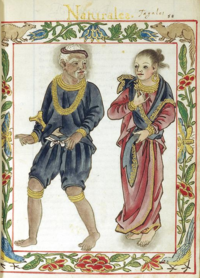 A couple belonging in the maginoo (noble class) | |
| Details | |
| Style | Maginoo Kamahalan Kapunuan |
| First monarch | Jayadewa (and other various rulers from the archipelago) |
| Last monarch | Mohammed Mahakuttah Abdullah Kiram (and other various rulers from the archipelago) |
| Formation | c. 900 (according to LCI) |
| Abolition | 1986 (after last officially recognized Sultan dies) |
| Residence | Torogan (Luzon and Visayas area), (Mindanao area) and Astanah Putih (in sultanate of Sulu) |
| Appointer | Babaylan, Brahmin or Bhikkhu (in Hindu/Buddhist-influenced polities) |
| Pretender(s) | various |
The types of sovereign state leaders in the Philippines have varied throughout the country's history, from heads of ancient chiefdoms, kingdoms and sultanates in the pre-colonial period, to the leaders of Spanish, American, and Japanese colonial governments, until the directly elected president of the modern sovereign state of the Philippines.
Archaic (pre-hispanic) Era[]
Before the nation of the Philippines was formed, the area of what was now the Philippines during the pre-colonial times was sets of divided nations ruled by Kings, Chieftains, Datus, Lakans, Rajahs and Sultans in Southeast Asia. It was when the Spaniards arrived that they named the collections of areas they conquered and unite in Southeast Asia as "Las Islas Filipinas" or The Islands of the Philippines.
Legendary rulers[]
- Legendary rulers can be found in the oral tradition in Philippine Mythology, which having an uncertain historical/archeological evidence of their reign.
| Image | Name | Title held | From | Until |
|---|---|---|---|---|
| Like most of the male Filipino mythological heroes, he is described as an attractive well-built man who exemplifies great strength. Ama-ron is unique among other Filipino legends due to the lack of having a story on how he was born which was common with Filipino epic heroes. | Uncertain possibly Iron Age. | |||
| Gat Pangil | Gat Pangil was a chieftain in the area now known as Laguna Province, He is mentioned in the origin legends of Bay, Laguna,Pangil, Laguna, Pakil, Laguna and Mauban, Quezon, all of which are thought to have once been under his domain. | Uncertain possibly Iron Age. |
Archaic rulers[]
Wang of Ma-i
| Name | Image | Title held | From | Until |
|---|---|---|---|---|
| Unnamed | 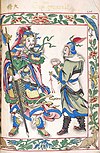 |
"王" 王 (King) according to Chinese records | 1225? | ? |
| Unnamed | "王" 王 (King) | 1339? | ? |
Huangdom of Pangasinan (Luyag na Kaboloan)
| Ruler | Image | Event | From | Until |
|---|---|---|---|---|
| Urduja | Pangasinan enjoys prosperity. | before 1368 | ? | |
| Kamayin (細馬銀) | Tribute of silver and horses to China. | 1406 | 1408 | |
| Taymey | Embassy to China was formally established. | 1408 | 1409 | |
| Yongle Emperor (Honorary) |
 |
Chinese Emperor holds a banquet in honor of Pangasinan | December 11, 1411 | ? |
| Chinese Warlord Limahong | Pangasinan is sacked and a pirate-enclave is established. | 1575 |
Historical rulers of Tondo
| Image | Name | Title held | From | Until |
|---|---|---|---|---|
| Unnamed | Senapati (Admiral) (Known only in the LCI as the ruler who give the pardon to Lord and his wife and their daughter named Bukah for their excessive debts in 900 AD.) |
900? | ? | |
| Lontok | (Gat and later Rajah) Lontok, ruler of Tondo husband of Dayang Kalangitan. | 1430? | 1450? | |
| Lakan Dula | Banaw Lakandula, Ruler of Tondo | 1558? | 1571 | |
| Agustin de Legazpi | The last ruler of Tondo. He was appointed to the position after the death of Lakandula. The monarchy is dissolved by the Spanish authorities after he leads the Tondo conspiracy | 1575 | 1589 |
Recorded rulers of Namayan[]
| Title | Name | Notes | Documented Period of Rule | Primary Sources |
|---|---|---|---|---|
| Lakan[1] | Tagkan[1] | Named "Lacantagcan" by Huerta and described as the ruler to whom the "original residents" of Namayan trace their origin[1] | exact years not documented; three generations prior to Calamayin | Huerta |
| (title not documented by Huerta[1]) | Palaba | Noted by Huerta[1] as the "Principal Son" of Lakan Tagkan. | exact years not documented; two generations prior to Calamayin[1] | Huerta |
| (title not documented by Huerta[1]) | Laboy | Noted by Franciscan genealogical records to be the son of Lakan Palaba, and the father of Lakan Kalamayin.[1] | exact years not documented; one generation prior to Calamayin[1] | Huerta |
| Rajah[2] | Kalamayin | Named only "Calamayin" (without title) by Huerta,[1] referred to by Scott (1984) as Rajah Kalamayin.[2] Described by Scott (1984)[2] as the paramount ruler of Namayan at the time of colonial contact. |
immediately prior to and after Spanish colonial contact (ca. 1571–1575)[2] | Huerta |
| (no title documented by Huerta[1]) | Martin* | *Huerta[1] does not mention if Kalamayin's son, baptized "Martin", held a government position during the early Spanish colonial period | early Spanish colonial period | Huerta |
| Legendary rulers of Namayan | |
|---|---|
| Aside from the records of Huerta, a number of names of rulers are associated with Namayan by folk/oral traditions, as recounted in documents such as the will of Fernando Malang (1589) and documented by academics such as Grace Odal-Devora[3] and writers such as Nick Joaquin.[4] |
| Title | Name | Notes | Period of Rule | Primary Sources |
|---|---|---|---|---|
| Gat[attribution needed] | Lontok | In Batangueño Folk Tradition as cited by Odal-Devora,[3] husband of Kalangitan, serving as "rulers of Pasig" together.[3]: 51 | Legendary antiquity[3] | Batangueño folk tradition (cited by Odal-Devora, 2000[3]) |
| Dayang[attribution needed] or Sultana[3][note 1] | Kalangitan[3] | Legendary "Lady of the Pasig"[3] in Batangueño Folk Tradition and "Ruler of Sapa" in Kapampangan Folk Tradition (as documented by Odal-Devora[3]). Either the mother in law (Batangueño Tradition) or grandmother (Kapampangan Tradition) of the ruler known as "Prinsipe Balagtas"[3] |
Legendary antiquity[3] | Batangueño and Kapampangan folk traditions (cited by Odal-Devora, 2000[3]) |
| "Princess" or "Lady" (term used in oral tradition, as documented by Odal-Devora[3]) |
Sasaban | In oral Tradition recounted by Nick Joaquin and Leonardo Vivencio, a "lady of Namayan" who went to the Madjapahit court to marry Emperor Soledan, eventually giving birth to Balagtas, who then returned to Namayan/Pasig in 1300.[3]: 51 | prior to 1300 (according to oral tradition cited by Joaquin and Vicencio)[3] |
Batangueño folk tradition (cited by Odal-Devora, 2000[3]), and oral tradition cited by Joaquin and Vicencio[3]) |
| Prince[3] (term used in oral tradition, as documented by Odal-Devora[3]) |
Bagtas or Balagtas | In Batangueño Folk Tradition as cited by Odal-Devora,[3] the King of Balayan and Taal who married Panginoan, daughter of Kalangitan and Lontok who were rulers of Pasig.: 51 In Kapampangan[3] Folk Tradition as cited by Odal-Devora,[3] the "grandson of Kalangitan" and a "Prince of Madjapahit" who married the "Princess Panginoan of Pampanga": 47, 51 Either the son in law (Batangueño Tradition) or grandson (Kapampangan Tradition) of Kalangitan[3] In oral tradition recounted by Nick Joaquin and Leonardo Vivencio, the Son of Emperor Soledan of Madjapahit who married Sasaban of Sapa/Namayan. Married Princess Panginoan of Pasig at about the year 1300 in order to consolidate his family line and rule of Namayan[3]: 47, 51 |
ca. 1300 A.D. according to oral tradition cited by Joaquin and Vicencio[3] | Batangueño and Kapampangan folk traditions cited by Odal-Devora, and oral tradition cited by Joaquin and Vicencio[3]) |
| "Princess" or "Lady" (term used in oral tradition, as documented by Odal-Devora[3]) |
Panginoan | In Batangueño Folk Tradition as cited by Odal-Devora,[3] the daughter of Kalangitan and Lontok who were rulers of Pasig, who eventually married Balagtas, King of Balayan and Taal.: 51 In Kapampangan[3] Folk Tradition as cited by Odal-Devora,[3] who eventually married Bagtas, the "grandson of Kalangitan.": 47, 51 In oral tradition recounted by Nick Joaquin and Leonardo Vivencio, "Princess Panginoan of Pasig" who was married by Balagtas, the Son of Emperor Soledan of Madjapahit in 1300 AD in an effort consolidate rule of Namayan[3]: 47, 51 |
ca. 1300 A.D. according to oral tradition cited by Joaquin and Vicencio[3] | Batangueño and Kapampangan folk traditions cited by Odal-Devora, and oral tradition cited by Joaquin and Vicencio[3]) |
The Datus of Madja-as[]
| Commander-In-Chief | Image | Capital | From | Until |
|---|---|---|---|---|
| Datu Puti | Aklan | 13th century | 1212 | |
| Datu Sumakwel | Malandong (today in Antique) | 1213 | ? | |
| Datu Bangkaya | Aklan | ? | ? | |
| Datu Paiburong | Irong-Irong | ? | ? | |
| Datu Balengkaka | Aklan | ? | ? | |
| Datu Kalantiaw | Batan | 1365 | 1437 | |
| Datu Manduyog | Batkcan | 1437 | ? | |
| Datu Padojinog | Irong-Irong | ? | ? | |
| Datu Kabnayag | Kalibo | ? | 1565 | |
| Datu Lubay | San Joaquín | ? | ? |
The Datus of Katugasan[]
| The Reigning Datu | Events | From | Until |
|---|---|---|---|
| Kihod | last reigning monarch of the Kedatuan of Katugasan[5] | ? | 1565 |
The Datus of Dapitan[]
| The Reigning Datu | Events | From | Until |
|---|---|---|---|
| Sumanga | Datu Sumanga raids China to win the hand of Dayang-dayang (Princess) Bugbung Humasanum | ? | ? |
| Dailisan | The Kedatuan was destroyed by the Sultanate of Ternate | 1563 | ? |
| Pagbuaya | The Kedatuan is re-established in Mindanao | ? | 1564 |
| Manooc | The Kedatuan is incorporated to the Spanish Empire | ? | ? |
Rulers of Maynila[]
| Name | Image | Events | From | Until |
|---|---|---|---|---|
| Salalila | Rajah Salalila or Rajah Sulayman I By this time, Manila was already under the influence of Brunei. |
1500 | 1515? | |
| Matanda | Rajah Matanda or Rajah Ache | 1521 | 1571 | |
| Sulayman | Rajah Sulayman III, Rajah of Manila | 1571 | 1575 |
| Legendary rulers of Maynila |
|---|
| Title | Name | Specifics | Dates | Primary source(/s) | Academic notes on primary source(/s) |
|---|---|---|---|---|---|
| Rajah | Avirjirkaya | According to Henson (1955),[6] he was a "Majapahit Suzerain" who ruled Maynila[6] before he was defeated in 1258[6] by a Bruneian naval commander named Rajah Ahmad,[6] who then established Manila as a Muslim principality.[6] | before 1258[7] | Genealogy proposed by Mariano A. Henson in 1955[6] | Cited in César Adib Majul's 1973 book "Muslims in the Philippines",[7] published by the UP Asian Center and in turn referenced widely in semitechnical and popular texts. The veracity of "quasi-historical" (meaning not physically original)[8] genealogical documents remains subject to scholarly peer review.[9][10] |
| Rajah | Ahmad | According to Henson (1955),[6] he established Manila as a Muslim[6] principality in 1258[6] by defeating the Majapahit Suzerain Rajah Avirjirkaya.[6] | c. 1258[7] | Genealogy proposed by Mariano A. Henson in 1955[6] | Cited in César Adib Majul's 1973 book "Muslims in the Philippines",[7] published by the UP Asian Center and in turn referenced widely in semi-technical and popular texts. The veracity of "quasi-historical" (meaning not physically original)[8] genealogical documents remains subject to scholarly peer review.[9][10] |
Monarchs of the Butuan Rajahnate[]
| The Royal Title of the Reigning Rajah | Image | Events | From | Until |
|---|---|---|---|---|
| Rajah Kiling | The Embassy of I-shu-han (李竾罕) | 989 | 1009 | |
| Sri Bata Shaja | Mission by Likanhsieh (李于燮) | 1011 | ? | |
| Rajah Siagu | Annexation by Ferdinand Magellan | ? | 1521 |
Rajahs of Cebu[]
| The Royal Title of the Reigning Rajah | Image | Events | From | Until |
|---|---|---|---|---|
| Sri Lumay | Founded the rajahnate, he is a minor prince of the Chola dynasty which occupied Sumatra. He was sent by the Maharajah to establish a base for expeditionary forces but he rebelled and established his own independent rajahnate. | c. 1200 | ? | |
| Rajah Humabon | The Rajah of Cebu at the time Ferdinand Magellan arrived at Cebu and is the first Filipino chieftain to embrace Christianity. | ? | ? | |
| Rajah Tupas | Last Rajah of Cebu, he ceded the Rajahnate to the Spanish Empire when he is defeated by Miguel López de Legazpi's forces in 1565. | ? | 1565 |
Sultans of Maguindanao[]
| Reign | Sultan | Other name(s) | |
|---|---|---|---|
| 1520–1543 | Shariff Kabungsuwan | A Johore (Singapore) Makdum Prince who fled to Malabang, Lanao del Sur and seated as Sharif Kabungsuwan. Married the daughter of Chieftain Aliwya of the Maguindanao family clan at Dulawan, Cotabato. Took over the father inlaw's political powers establishing the Sultanate of Maguindanao later called by the Spanish as Mindanao. He is the second Makdum known as Karim Ul-Makdum who reinforced Islam and His brother Sulu Sultan Shariful Hashim promulgated Kor'anic studies or Madrassahs.
The said Sharif is buried at Simunul Island Tamppat. | |
| 1543–1574 | Sultan Maka-alang Saripada | ||
| 1574–1578 | Sultan Bangkaya | ||
| 1578–1585 | Sultan Dimasangcay Adel | ||
| 1585–1597 | Sultan Gugu Sarikula | Datu Salikala | |
| 1597–1619 | Sultan Laut Buisan | Datu Katchil | |
| 1619–1671? | Sultan Muhammad Dipatuan Kudarat | Datu Qudratullah Katchil | |
| 1671?–1678? | Sultan Dundang Tidulay | Sultan Saif ud-Din (Saifud Din) | |
| 1678?–1699 | Sultan Barahaman | Sultan Muhammad Shah Minulu-sa-Rahmatullah | |
| 1699–1702 | Sultan Kahar ud-Din Kuda | Maulana Amir ul-Umara Jamal ul-Azam | |
| 1702–1736 | Sultan Bayan ul-Anwar { Maruhom Batua } | Dipatuan Jalal ud-Din Mupat Batua (posthumously) | |
| 1710–1736 (in Tamontaka) |
Sultan Amir ud-Din | Paduka Sri Sultan Muhammad Jafar Sadiq Manamir Shahid Mupat (posthumously) | |
| 1736–1748 (in Sibugay, Buayan, Malabang) |
Sultan Muhammad Tahir ud-Din | Dipatuan Malinug Muhammad Shah Amir ud-Din | |
| 1733–1755 (paramount chief of Maguindanao by 1748) |
Sultan Rajah Muda Muhammad Khair ud-Din | Pakir Maulana Kamsa Amir ud-Din Itamza Azim ud-Din Amir ul-M'umimin | |
| 1755–1780? | Sultan Pahar ud-Din | Datu Panglu/Pongloc Mupat Hidayat (posthumously) | |
| 1780?–1805? | Sultan Kibad Sahriyal | Muhammad Azim ud-Din Amir ul-Umara | |
| 1805?–1830? | Sultan Kawasa Anwar ud-Din | Muhammad Amir ul-Umara Iskandar Jukarnain | |
| 1830–1854 | Sultan Qudratullah Untung | Iskandar Qudratullah Muhammad Jamal ul-Azam Iskandar Qudarat Pahar ud-Din. Properly place, his name was Ullah Untong and seated as Sultan Ashrf Samalan Farid Quadratullah or better known as Sultan Qudarat. www.royalsultanate.weebly.com | |
| 1854–1884 | Sultan Muhammad Makakwa | ||
| 1884–1888 | Sultan Wata | Sultan Muhammad Jalal ud-Din Pablu | |
| 1888–1896 | No sultan Sultan Anwar ud-Din contested Datu Mamaku (son of Sultan Qudratullah Untung) of Buayan for the throne versus the then sultan Datu Mangigin of Sibugay. |
||
| 1896–1898 | Sultan Taha Colo | Sultan Rabago sa Tiguma | |
| 1908–1933 | Sultan Mastura Kudarat | Sultan Muhammad Hijaban Iskandar Mastura Kudarat, Sultan Mastura | |
The Sultans of Sulu (1405–present)[]
Succeeded by kinship Maharaja Adinda Taup upon the loss of the Sultanate, then usurped by Sultan Jamalul Agdam granting the leased treaty to the British in 1878, then later succeeded by Sultan Badar'uddin-II then by the Spanish proclaimed Sultan Harun Ar-Rashid then by the 1884–1915 Amirul Kiram Awal-II (Sultan Jamalul Kiram-II), the latter who surrendered his temporal powers to the Americans in exchange for a lifetime pension. Succeeded 21 years later by the 1957 Sultan Ismael Kiram to the present Kirams.| Sultans | Image | From | Until |
|---|---|---|---|
| Sharif ul-Hāshim |  |
1480 | 1505 |
| Kamal ud-Din |  |
1505 | 1527 |
| Sultan Amir ul-Umara |  |
1893 | 1899 |
| Jamal ul-Kiram I |  |
1825 | 1839, the progeny of the 1752 Kiram Sinsuat, Kiram Misuari and Kiram Sorronga. |
| Mahakuttah Kiram |  |
1974 | 1986 |
| Muedzul Lail Tan Kiram |  |
1986 |
Philippines Era[]
The collection of islands conquered by the Spaniards was named Las islas Filipinas; a name given by Ruy López de Villalobos. It's the exact geographical location on which the modern day Republic of the Philippines based its territory.
Rulers during the Spanish colonization[]
During the Spanish colonization, Remaining monarchs reign until their kingdoms was absorbed to the new colonial nation of the Philippines through Spanish conquest. Many of these territories are absorbed much later.
- Rajah Colambu – King of Limasawa in 1521, brother of Rajah Siagu of Butuan. He befriended Portuguese explorer Ferdinand Magellan and guided him to Cebu on April 7, 1521.
- Rajah Humabon – King of Cebu who became an ally of Ferdinand Magellan and the Spaniards. Rival of Datu Lapu-Lapu. In 1521, he and his wife were baptized as Christians and given Christian names Carlos and Juana after the Spanish royalty, King Carlos and Queen Juana.
- Sultan Kudarat – Sultan of Maguindanao.
- Lakan Dula or Lakandula – King of Tondo, one of the last princes of Manila.
- Datu Lapu-Lapu – King of Mactan Island. He defeated the Spaniards on April 27, 1521.
- Datu Sikatuna – King of Bohol in 1565. He made a blood compact with Spanish explorer, Miguel López de Legazpi.
- Datu Pagbuaya – King of Bohol. He governed with his brother Datu Dailisan, a settlement along the shorelines between Mansasa, Tagbilaran and Dauis, which was abandoned years before the Spanish colonization due to Portuguese and Ternatean attacks. He founded Dapitan in the northern shore of Mindanao.
- Datu Dailisan – King of Mansasa, Tagbilaran and Dauis and governed their kingdom along with his brother Datu Pagbuaya. His death during one of the Portuguese raids caused the abandonment of the settlement.
- Datu Manooc – Christian name – Pedro Manuel Manooc, son of Datu Pagbuaya who converted to Christianity, defeated the Higaonon tribe in Iligan, Mindanao. He established one of the first Christian settlements in the country.
- Datu Macabulos – King of Pampanga in 1571.
- Rajah Siagu – King of the Manobo in 1521.
- Apo Noan – Chieftain of Mandani (present day Mandaue) in 1521.
- Apo Macarere – Famous Chieftain of the Tagbanwa warrior tribe in Corong Island (Calis).
- Rajah Sulaiman III – One of the last King of Manila, was defeated by Martín de Goiti, a Spanish soldier commissioned by López de Legazpi to Manila.
- Rajah Tupas – King of Cebu, conquered by Miguel López de Legazpi.
- Datu Urduja – Female Leader in Pangasinan.
- Datu Zula – Chieftain of Mactan, Cebu. Rival of Lapu-lapu
- Datu Kalun – Ruler of the Island of the Basilan and the Yakans in Mindanao, converted his line to Christianity
- Datu Sanday – Ruler of Marawi City
- Datu Saiden Borero – King of Antique
- unnamed Datu – King of Taytay Palawan. Mentioned by Pigafetta, chronicler of Magellan. The king, together with his wife were kidnapped by the remnant troops from Magellan's fleet after fleeing Cebu to secure provisions for their crossing to the Moluccas.
- Datu Cabaylo (Cabailo) – The last king of the Kingdom of Taytay
Captaincy-General of the Philippines (1565–1761)[]
From 1565 to 1898, the Philippines was under Spanish rule. From 1565 to 1821, The governor and captain-general was appointed by the Viceroy of New Spain upon recommendation of the Spanish Cortes and governed on behalf of the Monarch of Spain. When there was a vacancy (e.g. death, or during the transitional period between governors), the Real Audiencia in Manila appoints a temporary governor from among its members.
| Monarch | Image | From | Until | House |
|---|---|---|---|---|
| Philip II | 
|
April 27, 1565 | September 13, 1598 | Habsburg |
| Philip III | 
|
September 13, 1598 | March 31, 1621 | |
| Philip IV | 
|
March 31, 1621 | September 17, 1665 | |
| Charles II | 
|
September 17, 1665 | November 1, 1700 | |
| Philip V | 
|
November 16, 1700 | January 14, 1724 | Bourbon |
| Louis I | 
|
January 14, 1724 | August 31, 1724 | |
| Philip V | 
|
September 6, 1724 | July 9, 1746 | |
| Ferdinand VI | 
|
July 9, 1746 | August 10, 1759 | |
| Charles III | 
|
August 10, 1759 | December 14, 1788 |
During Revolts against Spain (1660–1661)[]
| Name | Image | From | Until | Notes |
|---|---|---|---|---|

|
1660 | 1661 | a Filipino revolutionary leader who conspired to overthrow Spanish rule in the northern Philippines and establish an independent Kapampangan nation in Pampanga, with him as "King of Pampanga." |
| Name | Image | From | Until | Notes |
|---|---|---|---|---|
| Andres Malong | 1660 | 1661 | a Filipino revolutionary leader who conspired to overthrow Spanish rule in the northern Philippines and establish an independent Pangasinense nation in Pangasinan, with him as "King of Pangasinan." |
| Name | Image | From | Until | Notes |
|---|---|---|---|---|
| Pedro Almazán | 1661 | 1661 | a Filipino revolutionary leader who conspired to overthrow Spanish rule in the northern Philippines and establish an independent Ilocano nation in Ilocos, with him as "King of Ilocos." |
British Occupation of Manila (1761–1764)[]
Great Britain occupied Manila and the naval port of Cavite as part of the Seven Years' War.
| Monarch | Image | From | Until | House |
|---|---|---|---|---|
| George III | 
|
November 2, 1762 | May 31, 1764 | Hanover |
Independent Ilocos (1762–1763)[]
| Name | Image | From | Until | Notes |
|---|---|---|---|---|
| Diego Silang | 
|
1762 | 1763 | a Filipino revolutionary leader who conspired with British forces to overthrow Spanish rule in the northern Philippines and establish an independent Ilocano nation. |
Under New Spain (1764–1821)[]
| Monarch | Image | From | Until | House |
|---|---|---|---|---|
| Charles III | 
|
August 10, 1759 | December 14, 1788 | Bourbon |
| Charles IV | 
|
December 14, 1788 | March 19, 1808 | |
| Ferdinand VII | 
|
March 19, 1808 | May 6, 1808 | |
| Joseph I | 
|
December 11, 1813 | September 29, 1833 | Bonaparte |
Emperor[]
| Name | Image | From | Until | Notes |
|---|---|---|---|---|
| Andrés Novales | 1823 | 1823 | His discontentment with the treatment of creole soldiers led him to start a revolt in 1823 that inspired even the ranks of José Rizal. He successfully captured Intramuros and was proclaimed Emperor of the Philippines by his followers. However, he was defeated within the day by Spanish reinforcements from Pampanga.[11] |
Spanish East Indies (1821–1898)[]
After the 1821 Mexican War of Independence, Mexico became independent and was no longer part of the Spanish Empire. The Viceroyalty of New Spain ceased to exist. The Philippines, as a result, was directly governed from Madrid, under the Crown.
| Monarch | Image | From | Until | House |
|---|---|---|---|---|
| Joseph I | 
|
December 11, 1813 | September 29, 1833 | Bonaparte |
| Ferdinand VII | 
|
December 11, 1813 | September 29, 1833 | Bourbon |
| Isabella II | 
|
September 29, 1833 | September 30, 1868 | |
| Amadeo I | 
|
December 4, 1870 | February 11, 1873 | Savoy |
| President | Image | From | Until | Party |
| Estanislao Figueras | 
|
February 12, 1873 | June 11, 1873 | Federal Democratic Republican Party |
| Francesc Pi i Margall | 
|
June 11, 1873 | July 18, 1873 | |
| Nicolás Salmerón y Alonso | 
|
July 18, 1873 | September 7, 1873 | |
| Emilio Castelar y Ripoll | 
|
September 7, 1873 | January 3, 1874 | |
| Francisco Serrano, 1st Duke of la Torre | 
|
January 3, 1874 | December 30, 1874 | Conservative |
| Monarch | Image | From | Until | House |
| Alfonso XII | 
|
December 30, 1874 | November 25, 1885 | Bourbon |
| Alfonso XIII | 
|
May 17, 1886 | December 10, 1898 |
Revolutionary Republics and States[]
The Ruling Leaders during Philippine Revolution[]
| President | Image | From | Until |
|---|---|---|---|
| Andres Bonifacio | 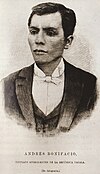 |
1896 | 1897 |
| President | Image | From | Until |
|---|---|---|---|
| Emilio Aguinaldo |  |
1897 | December 15, 1897 |
| President | Image | From | Until |
|---|---|---|---|
| Emilio Aguinaldo |  |
1897 | 1901 |
| Miguel Malvar | 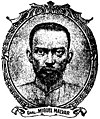 |
1901 | 1902 |
| President | Image | From | Until |
|---|---|---|---|
| Macario Sakay |  |
1902 | 1906 |
| President | Image | From | Until |
|---|---|---|---|
| Vicente Alvarez | 1899 | 1899 | |
| 1899 | 1901 | ||
| Mariano Arquiza | 1901 | 1903 |
| President | Image | From | Until |
|---|---|---|---|
| Aniceto Lacson |  |
1898 | 1899 |
| Melecio Severino | 1899 | 1901 |
United States Military Government (1898–1901)[]
The American military government was established following the defeat of Spain in the Spanish–American War. During the transition period, executive authority in all civil affairs in the Philippine government was exercised by the military governor.
| President | Image | From | Until | Party |
|---|---|---|---|---|
| William McKinley | 
|
December 10, 1898 | September 14, 1901 | Republican |
Insular Government (1901–1935)[]
On July 4, 1901, executive authority over the islands was transferred to the president of the Second Philippine Commission who had the title of Civil Governor, a position appointed by the President of the United States and approved by the United States Senate. For the first year, a Military Governor, Adna Chaffee, ruled parts of the country still resisting the American rule, concurrent with civil governor, William Howard Taft.[12] Disagreements between the two were not uncommon.[13] The following year, on July 4, 1902, Taft became the sole executive authority.[14] Chaffee remained as commander of Philippine Division until September 30, 1902.[15]
The title was changed to Governor General in 1905 by an act of Congress (Public 43 – February 6, 1905).[14] The term "insular" (from insulam, the Latin word for island)[16] refers to U.S. island territories that are not incorporated into either a state or a federal district. All insular areas was under the authority of the U.S. Bureau of Insular Affairs, a division of the US War Department.[17][18]
| President | Image | From | Until | Party |
|---|---|---|---|---|
| William McKinley | 
|
December 10, 1898 | September 14, 1901 | Republican |
| Theodore Roosevelt | 
|
September 14, 1901 | March 4, 1909 | |
| William Howard Taft | 
|
March 4, 1909 | March 4, 1913 | |
| Woodrow Wilson | 
|
March 4, 1913 | March 4, 1921 | Democratic |
| Warren G. Harding | 
|
March 4, 1921 | August 2, 1923 | Republican |
| Calvin Coolidge | 
|
August 2, 1923 | March 4, 1929 | |
| Herbert Hoover | 
|
March 4, 1929 | March 4, 1933 | |
| Franklin D. Roosevelt | 
|
March 4, 1933 | April 12, 1945 | Democratic |
| Harry S. Truman | 
|
April 12, 1945 | July 4, 1946 |
Philippine Commonwealth (1935–1946)[]
On November 15, 1935, the Commonwealth of the Philippines was inaugurated as a transitional government to prepare the country for independence. The office of President of the Philippine Commonwealth replaced the Governor-General as the country's chief executive. The Governor-General became the High Commissioner of the Philippines with Frank Murphy, the last governor-general, as the first high commissioner. The High Commissioner exercised no executive power but rather represented the colonial power, the United States Government, in the Philippines. The high commissioner moved from Malacañang Palace to the newly built High Commissioner's Residence, now the Embassy of the United States in Manila.
After the Philippine independence on July 4, 1946, the last High Commissioner, Paul McNutt, became the first United States Ambassador to the Philippines.
| President | Image | From | Until | Party |
|---|---|---|---|---|
| Manuel L. Quezon | 
|
November 15, 1935 | August 1, 1944 | Nacionalista |
| Sergio Osmeña | 
|
August 1, 1944 | May 28, 1946 | |
| Manuel Roxas | 
|
May 28, 1946 | April 15, 1948 | Liberal |
Japanese Military Governors (1942–1945)[]
In December 1941, the Commonwealth of the Philippines was invaded by Japan as part of World War II. The next year, the Empire of Japan sent a military governor to control the country during wartime, followed by the formal establishment of the puppet second republic.[19]
| Emperor | Image | From | Until | House |
|---|---|---|---|---|
| Hirohito | 
|
January 3, 1942 | September 2, 1945 | Imperial House of Japan |
Second Philippine Republic (1943–1945)[]
The Second Republic was inaugurated on October 14, 1943, in Manila, and ended when President Jose P. Laurel dissolved the republic on August 17, 1945, in Tokyo.
| President | Image | From | Until | Party |
|---|---|---|---|---|
| Jose P. Laurel | 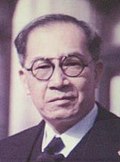
|
October 14, 1943 | August 17, 1945 | KALIBAPI |
Third Philippine Republic (1946–1972)[]
The Third Republic started when independence was granted by the Americans on July 4, 1946, and ended upon the imposition of martial law by President Ferdinand Marcos on September 21, 1972.
| President | Image | From | Until | Party |
|---|---|---|---|---|
| Manuel Roxas | 
|
May 28, 1946 | April 15, 1948 | Liberal |
| Elpidio Quirino | 
|
April 17, 1948 | December 30, 1953 | |
| Ramon Magsaysay | 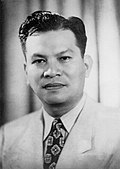
|
December 30, 1953 | March 17, 1957 | Nacionalista |
| Carlos P. Garcia | 
|
March 18, 1957 | December 30, 1961 | |
| Diosdado Macapagal | 
|
December 30, 1961 | December 30, 1965 | Liberal |
| Ferdinand Marcos | 
|
December 30, 1965 | February 25, 1986 | Nacionalista |
Martial law, New Society, and the Fourth Philippine Republic (1972–1987)[]
President Ferdinand Marcos ruled by decree when he declared martial law on September 21, 1972. He inaugurated the "New Society" after a new constitution was ratified on January 17, 1973. He declared the Fourth Republic on January 17, 1981, after martial law was lifted.
| President | Image | From | Until | Party |
|---|---|---|---|---|
| Ferdinand Marcos | 
|
December 30, 1965 | February 25, 1986 | Nacionalista, later KBL |
| Corazon Aquino | 
|
February 25, 1986 | June 30, 1992 | UNIDO |
Provisional Government and Fifth Philippine Republic (1987–Present)[]
President Corazon Aquino, after ascending into office, issued Proclamation No. 3, the Freedom Constitution, ending the Fourth Republic and ushering in the Provisional Government. This called for the adoption of certain provisions of the 1973 constitution, but called for a constitutional commission that shall write a new one. She inaugurated the Fifth Republic after the present constitution was ratified. The plebiscite took place on February 2, 1987.
| President | Image | From | Until | Party |
|---|---|---|---|---|
| Corazon Aquino | 
|
February 25, 1986 | June 30, 1992 | UNIDO, later independent |
| Fidel V. Ramos | 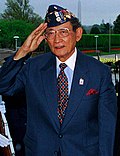
|
June 30, 1992 | June 30, 1998 | Lakas |
| Joseph Estrada | 
|
June 30, 1998 | January 20, 2001 | LAMMP |
| Gloria Macapagal Arroyo | 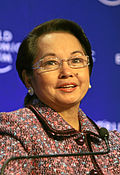
|
January 20, 2001 | June 30, 2010 | Lakas, later Lakas–Kampi |
| Benigno Aquino III | 
|
June 30, 2010 | June 30, 2016 | Liberal |
| Rodrigo Duterte | 
|
June 30, 2016 | Present | PDP–Laban |
See also[]
- President of the Philippines
- Governor-General of the Philippines
- Filipino styles and honorifics
- Heads of state and government of the Philippines
- First Lady or First Gentleman of the Philippines
- List of ancient Philippine consorts
- List of presidents of the Philippines
- List of Unofficial Presidents of the Philippines
- Vice President of the Philippines
- List of Vice Presidents of the Philippines
- Prime Minister of the Philippines (now defunct)
- Seal of the President of the Philippines
- List of current heads of state and government
Notes[]
- ^ The term "Sultana" is used by Odal-Devora in her essay The River Dwellers (2000, page 47), saying "This Prince Bagtas, a grandson of Sultana Kalangitan, the Lady of Pasig, was also said to have ruled the Kingdom of Namayan or Sapa, in the present Sta Ana-Mandaluyong-San Juan- Makati Area. This would explain the Pasig-Sta Ana-Tondo-Bulacan-Pampanga-Batangas interconnections of the Tagalog ruling elites."
Subnotes[]
References[]
- ^ Jump up to: a b c d e f g h i j k l Huerta, Felix, de (1865). Estado Geografico, Topografico, Estadistico, Historico-Religioso de la Santa y Apostolica Provincia de San Gregorio Magno. Binondo: Imprenta de M. Sanchez y Compañia.
- ^ Jump up to: a b c d Scott, William Henry (1994). Barangay: Sixteenth Century Philippine Culture and Society. Quezon City: Ateneo de Manila University Press. ISBN 971-550-135-4.
- ^ Jump up to: a b c d e f g h i j k l m n o p q r s t u v w x y z aa ab ac ad ae af ag Odal-Devora, Grace P. (2000). "The River Dwellers". In Alejandro, Reynaldo Gamboa (ed.). Pasig: River of Life. Water Series Trilogy. Unilever Philippines. ISBN 978-9719227205.
- ^ Joaquin, Nick (1990). Manila, My Manila: A History for the Young. City of Manila: Anvil Publishing, Inc. ISBN 978-971-569-313-4.
- ^ http://www.luzpalma.com/Information%20gather%20from%20the%20island%20of%20Siquijor.html
- ^ Jump up to: a b c d e f g h i j k Henson, Mariano A (1955). The Province of Pampanga and its towns (A.D. 1300–1955) with the genealogy of the rulers of central Luzon. Manila: Villanueva Books.
- ^ Jump up to: a b c d Majul, César Adib (1973). Muslims in the Philippines. Diliman: University of the Philippines Asian Center.
- ^ Jump up to: a b Scott, William Henry (1984). Prehispanic Source Materials for the Study of Philippine History. Quezon City: New Day Publishers. ISBN 978-9711002268.
- ^ Jump up to: a b Dery, Luis Camara (2001). A History of the Inarticulate. Quezon City: New Day Publishers. ISBN 978-971-10-1069-0.
- ^ Jump up to: a b Junker, Laura Lee (1998). "Integrating History and Archaeology in the Study of Contact Period Philippine Chiefdoms". International Journal of Historical Archaeology. 2 (4): 291–320. doi:10.1023/A:1022611908759.
- ^ Joaquin, Nick (1990). Manila,My Manila. Vera-Reyes, Inc.
- ^ Elliott (1917), p. 4
- ^ Tanner (1901), p. 383
- ^ Jump up to: a b Elliott (1917), p. 509
- ^ Philippine Academy of Social Sciences (1967). Philippine social sciences and humanities review. pp. 40.
- ^ "Island – from English to Latin". Google Translate. Retrieved on August 7, 2013.
- ^ "Definitions of Insular Area Political Organizations" Archived September 25, 2012, at the Wayback Machine. U.S. Department of the Interior.
- ^ "Insular". Merriam-Webster Dictionary. Retrieved on August 7, 2013.
- ^ Cahoon (2000)
Works cited[]
- Agoncillo, Teodoro A.; Guerrero, Milagros C. (1970). History of the Filipino People (3rd ed.). Malaya Books.
- Chandler, David Porter; Steinberg, David Joel (1987). In Search of Southeast Asia: A Modern History (Revised ed.). University of Hawaii Press. ISBN 0-8248-1110-0.
- Philippine Electoral Almanac (PDF) (Revised and expanded ed.). Manila: Presidential Communications Development and Strategic Planning Office. 2015. ISBN 978-971-95551-6-2 – via Internet Archive.
- Tucker, Spencer, ed. (2009). The Encyclopedia of the Spanish–American and Philippine–American Wars: A Political, Social, and Military History. 1 (Illustrated ed.). ABC-CLIO. ISBN 978-1-85109-951-1.
External links[]
- Office of the President of the Philippines
- The Presidential Museum and Library
- Philippine Heads of State Timeline at www.worldstatesmen.org
- Filipino royalty
- 1571 disestablishments
- States and territories established in 1500
- Former countries in Philippine history
- Former monarchies of Asia
- History of the Philippines (900–1565)
- National histories
- History of Manila
- States and territories established in the 1500s
- 1500 establishments in Asia

